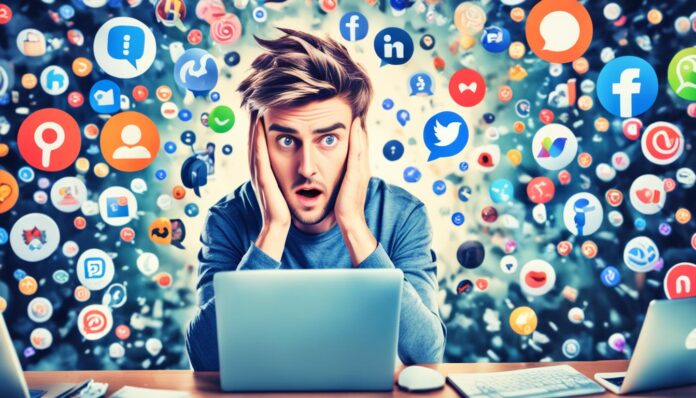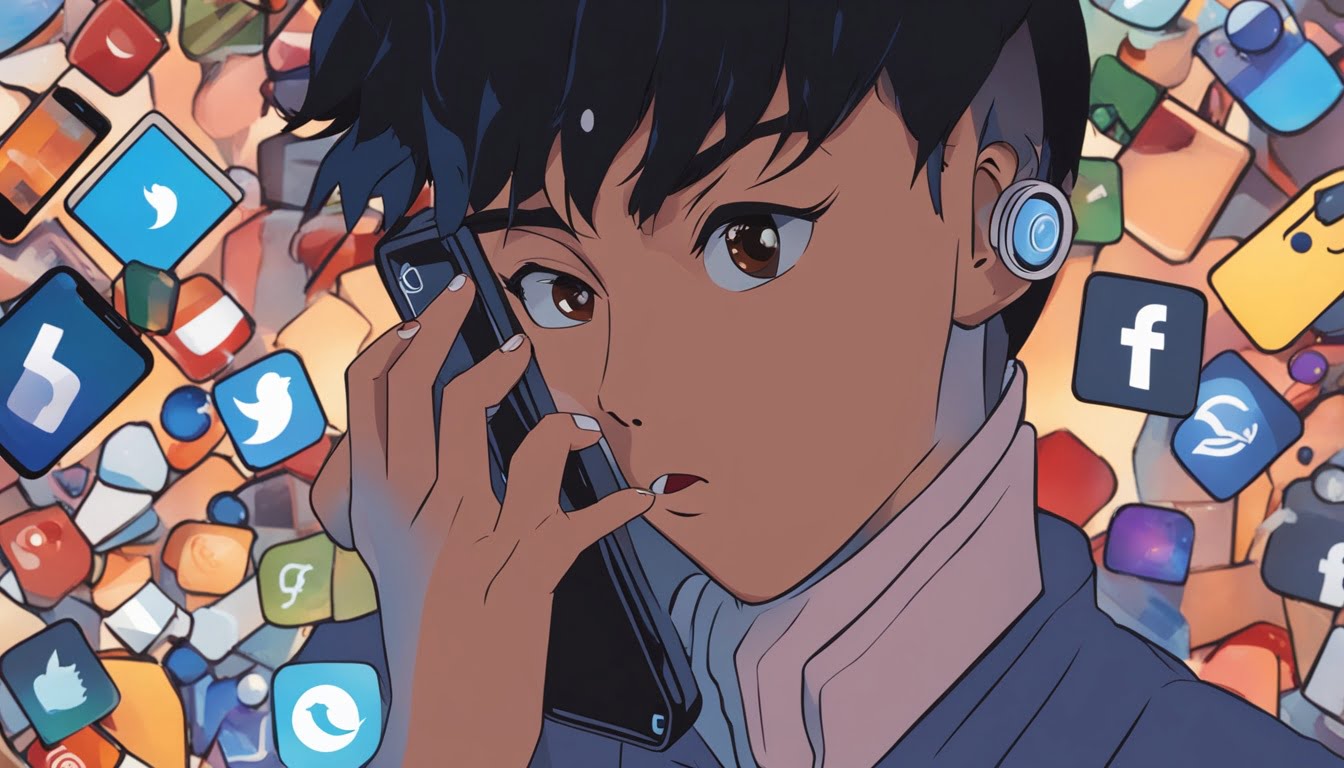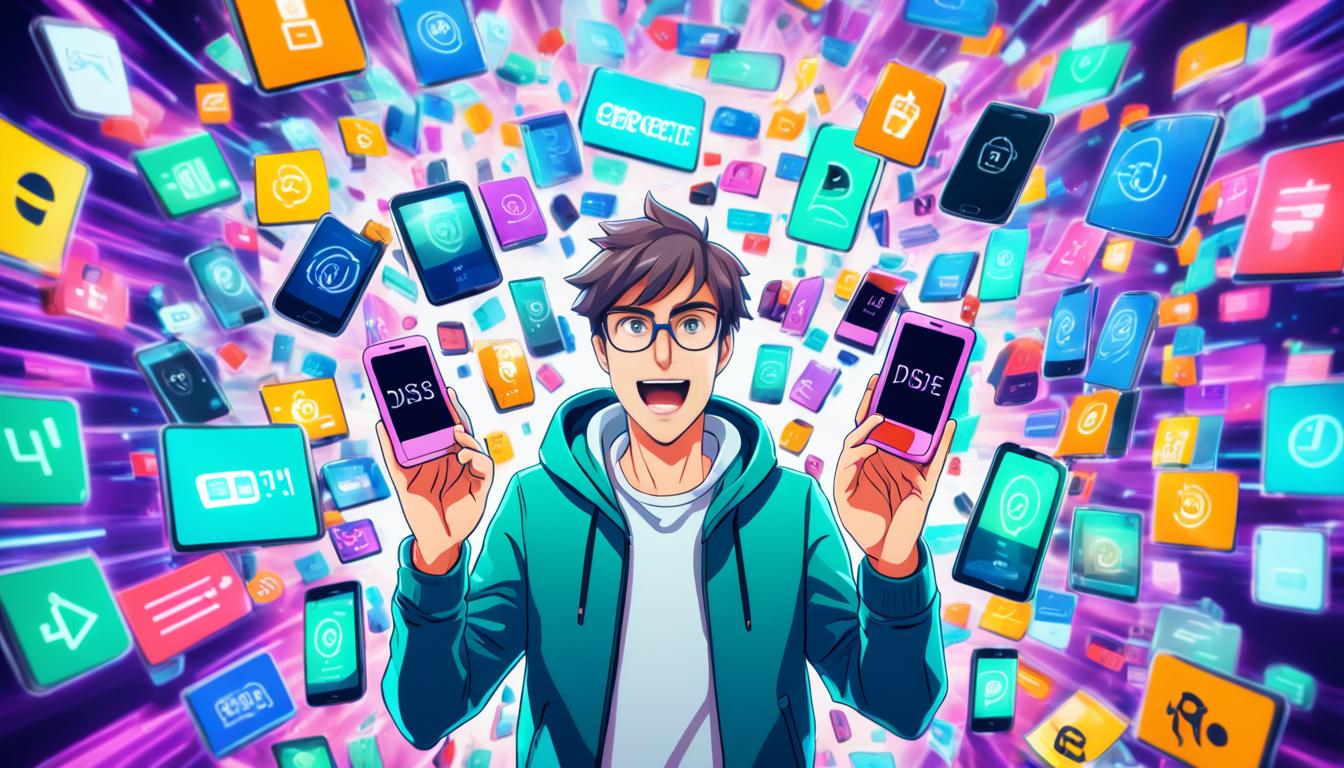
Using digital devices a lot can lead to too much information, known as digital overload. This can make you feel irritable, anxious, and have trouble sleeping. To avoid these problems, try to use screens less than two hours a day when not working, turn off notifications, and spend some time without technology.
Adults in the U.S. spend over 13 hours every day on digital media. This much time can change your mood, make you anxious, or even lead to depression. It’s really important to spot and fight social media addiction to take back control of your digital life.
Key Takeaways
- Reducing screen time to less than two hours outside of work hours helps
- Turning off notifications minimizes distractions
- Implementing tech-free times promotes mental well-being
- Excessive device use can lead to irritability and anxiety
- Over 13 hours of daily digital media exposure is common in the U.S.
Understanding Social Media Addiction
Social media addiction shows in how we can’t stop using it. When we know the signs early, we can learn to manage it.
What is Social Media Addiction?
Social media addiction is like being addicted to something. It’s hard to stop using social media, even when it’s causing problems in your life. It can make work or school harder, mess with relationships, and even hurt your health.
Signs and Symptoms of Social Media Addiction
The first step is to see if you’re using social media too much. Here are some signs to watch out for:
- Compulsive checking of social media apps
- Keeping away from real people
- Feeling bad physically, like your eyes hurting or not sleeping well
- Getting nervous or grumpy without social media
Getting likes and comments online can make us feel good. This makes our brains want to keep at it. It’s like how people can get hooked on gambling.
The Impact of Digital Overload
Digital devices are everywhere today, causing a rise in digital dependency. This trend affects our mental and physical health. Each person faces the effects of digital overload differently.

Mental Health Effects
Digital overload harms our mental well-being. It increases anxiety, affects our focus, and causes mood swings. Too much time online makes it hard to relax and disconnect. Many studies link heavy digital use to poor mental health, especially in teens. Sadly, more depression and suicide occur in people who use devices a lot. This shows the dangerous impact of digital overload on mental health.
Physical Health Effects
Besides mental health, leaning on digital tech causes physical problems. Overusing screens can lead to sleep issues and tired eyes. Staying up late on phones is bad for sleep, leading to ongoing tiredness. Sitting down a lot while on screens harms us too. It can cause bad posture, weight gain, and less fitness. Dealing with these physical health worries is key to living better with digital devices.
Knowing all these risks stresses the need to manage our screen time and find healthier digital habits.
| Health Impact | Consequences |
|---|---|
| Mental Health Effects | Anxiety, emotional dysregulation, concentration difficulties, increased rates of depression and suicide among teens |
| Physical Health Effects | Insomnia, eye strain, poor posture, weight gain, reduced physical fitness |
Causes of Social Media Addiction
Social media addiction is a mix of psychological needs and technology use. This part looks at why people get hooked on social media. It explores how our minds and the tools we use online keep us coming back.
Psychological Factors
Humans naturally seek social contacts and need validation. Online platforms meet these needs well. They offer quick likes and comments, which make us want more. This creates a habit that’s hard to break.
This need feels similar to what drug users and gamblers experience. It becomes hard to stop using social media because we always seek this approval.
Technological Factors
Technology also plays a big part in our social media addiction. The way apps are made keeps us interested. They use our data to show us what we like. Plus, notifications are made to catch and keep our attention.
This constant connection to social media can harm our mental health. It encourages us to expect quick rewards which deepen our addiction. This problem isn’t too different from other compulsive behaviors.
Recognizing Social Media Overuse
Spotting the signs of too much social media can help you avoid stress and burnout. Think about your social media habits. Do you spend a lot of time scrolling, neglecting things you once loved? This could be a warning sign.
A big part of noticing social networking overload awareness is realizing when it affects your productivity. It can lower your efficiency in daily tasks. Getting caught up in endless updates often leads to feeling stressed.

Also, what we see on social media can impact how we feel. Everything from happy news to bad events can change our mood. It’s important to know what makes you feel down. This can help you cut back on harmful social media use.
In conclusion, understanding how social media affects you can be the first step to change. Focus on noticing your social media patterns and use. This can lead to a better, healthier balance in your digital life.
Strategies to Combat Smartphone Addiction
In today’s world, it’s vital to balance screen time with real-life moments. These practical strategies against smartphone addiction can help you get a handle on your tech use.
Setting Screen Time Limits
One way to cut back on phone use is by setting limits. Pick specific times when you can’t use your phone much. Daily app limits help, too. They stop endless scrolling and make you more aware when you do use your phone.
Creating Tech-Free Zones
Set up tech-free zones in your home to really dive into real life. Places like your bedroom or dining room could be off-limits for devices. No phones there means deeper connections and better work focus.
Setting limits and tech-free zones go well together. They help you enjoy real life more. These steps make every day richer without too much phone time.
Tips for Managing Online Compulsive Behavior
Combatting online compulsive behavior needs a deliberate effort. A main strategy for online compulsive behavior management is setting clear boundaries. For example, choose specific times each day for using social media. Limiting your screen time can cut back on the constant urge to be online.
It’s crucial to make some places in your home tech-free. This separation helps you live in the real world rather than just the virtual one. It also makes using virtual world immersion solutions more balanced and intentional.
Choosing uplifting online content is also important. Follow pages and channels that make you feel good and help you grow. This includes educational sites, wellness influencers, and speakers who motivate you. They can be more helpful than reading bad news or endlessly scrolling.

Being mindful is key too. Adopt daily practices that keep you in the present, like meditation or deep breathing. These methods can lower the need for excess online time.
- Set specific times for social media use
- Create tech-free zones
- Prioritize positive content
- Practice mindfulness
| Strategy | Benefits |
|---|---|
| Scheduled Social Media Use | Reduces unnecessary screen time |
| Tech-Free Zones | Creates balance between digital and real-world interactions |
| Prioritizing Positive Content | Promotes mental well-being and positivity |
| Mindfulness Practices | Enhances presence and reduces compulsive tendencies |
Taking a smart approach to using digital media involves simple steps. By following these strategies, you can manage or avoid overusing the internet. This way, you develop a healthier attitude toward digital tools.
How to Perform a Digital Detox
Finding balance in our digital lives can be tough. But a digital detox can help you regain control and clear your mind. We’ll explore short and long-term ways to detox digitally.
Short-Term Digital Detox Methods
Short-term detox methods give quick relief from too much tech. Start by setting times for no device use, like in the morning or during dinner. Also, try “digital detox weekends,” where you keep all devices off and enjoy offline activities.
“Success with a short-term detox often lies in deliberately planning engaging offline activities to fill the void left by screen time.”
Long-Term Digital Hygiene Practices
For lasting digital health, you need lifelong habits. First, make rules like less screen time and tech-free areas in your home. You might also want to try therapy for more serious digital addiction. Taking regular tech breaks can keep you balanced and mindful around tech.
Here is a comparative table of short-term vs long-term digital detox strategies:
| Short-Term Detox Solutions | Long-Term Digital Health |
|---|---|
| Device-free Mornings/Evenings | Scheduled Screen Time Limits |
| Weekend Digital Retreats | Tech-Free Zones at Home |
| Temporary App Blocking | Therapy and Professional Support |
Using both short and long-term strategies can improve your tech relationship. This way, you can enjoy a healthier life with digital gadgets.
Replacing Social Media with Offline Activities
By cutting down screen time, we boost our mental and physical health. Stepping back from social media lets us enjoy the real world more. We break free from online obsession and find a balanced life.
Engaging in Physical Activities
Choosing offline activities over social media is a great move. Walking, running, or playing sports are fun and good for you. These hobbies help clear our minds and keep our emotions in check. They also make us happier and less anxious, countering the effects of too much screen time.
Developing New Hobbies
Getting into new hobbies is a fantastic way to use our time offline. Creativity in painting, gardening, or cooking brings joy. These hobbies meet our need for fulfillment and help us connect with others. They let us learn new things, grow as people, and form real bonds.
FAQ
What is Social Media Addiction?
Social media addiction is when using it a lot starts to hurt your daily life. You might find it hard to take a break. Signs are checking apps too much, pulling back from people to be online, and eye problems.
Signs and Symptoms of Social Media Addiction
Signs of being addicted to social media include getting mad, anxious, or finding it hard to sleep. Your body might hurt from too much screen time, like having headaches. You might also feel sad and want to be alone just to go online.
Mental Health Effects of Digital Overload
Using digital stuff too much can lead to problems like feeling anxious, not being able to focus, and being sad. Scientists say too much digital time can make depression and wanting to harm yourself more likely, especially if you’re young.
Physical Health Effects of Digital Overload
Digital overload can mess with your sleep, eyes, and hurt your body. Also, just sitting and looking at screens a lot can make you less healthy.
Psychological Factors Contributing to Social Media Addiction
Wanting to connect with others and be liked online can make you use social media too much. It’s kinda like how gambling and drinking can become big problems.
Technological Factors Contributing to Social Media Addiction
The apps and websites we use are made to hook us in. They do this by making us feel like we always need to check for new stuff and likes.
Recognizing Social Media Overuse
You can tell you’re using social media too much when it starts to stress you out. You might not enjoy other things as much, get less done, and feel sadder because of what you see online.
Setting Screen Time Limits
One way to stop using your phone too much is to set limits. You can say, “I will only use Instagram for an hour a day.” This way, you can find a good balance between the internet and real life.
Creating Tech-Free Zones at Home
Making some areas at home tech-free can help with digital addiction. Not using phones or computers in certain places or at certain times encourages other fun activities. It also helps keep your life balanced.
Tips for Managing Online Compulsive Behavior
To manage wanting to be online all the time, try setting rules and places where using tech is not allowed. Also, focusing on what makes you feel good when online can be helpful.
Short-Term Digital Detox Methods
Sometimes, it’s good to take a break from digital devices. This could be just for a day or a weekend. Turning off notifications is a simple way to start.
Long-Term Digital Hygiene Practices
For the long haul, it’s about keeping good tech habits. Try not to use screens too much and have plenty of times without them. Getting help from a professional can make this easier.
Engaging in Physical Activities
Doing physical stuff like walking or playing sports can make you focus less on the internet. It’s good for your mind and body.
Developing New Hobbies
Finding new things to do can replace the time you spend online. Crafting or cooking, for example, are great ways to have fun and relax without the internet.
